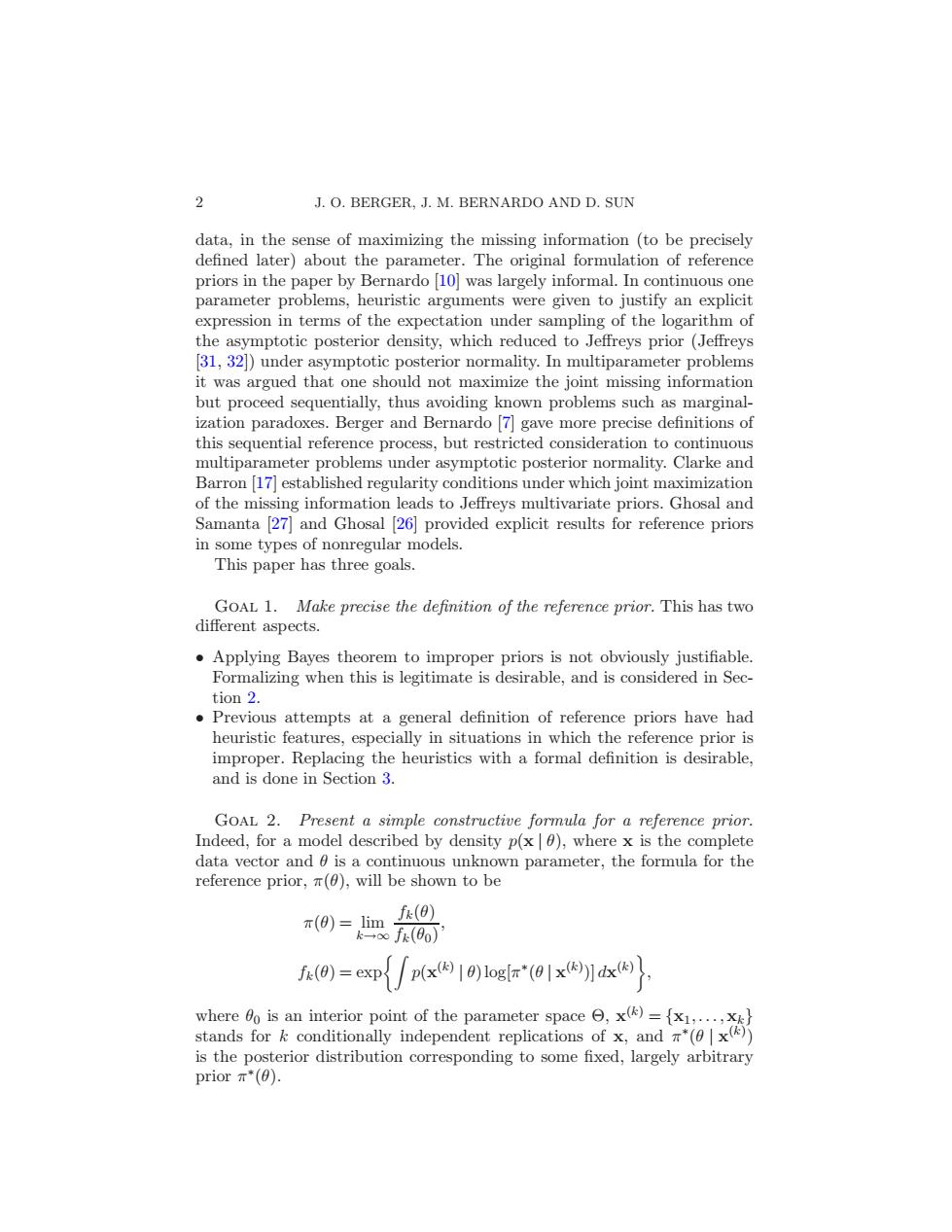正在加载图片...

2 J.O.BERGER.J.M.BERNARDO AND D.SUN data,in the sense of maximizing the missing information (to be precisely defined later)about the parameter.The original formulation of reference priors in the paper by Bernardo [10]was largely informal.In continuous one parameter problems,heuristic arguments were given to justify an explicit expression in terms of the expectation under sampling of the logarithm of the asymptotic posterior density,which reduced to Jeffreys prior (Jeffreys [31,32])under asymptotic posterior normality.In multiparameter problems it was argued that one should not maximize the joint missing information but proceed sequentially,thus avoiding known problems such as marginal- ization paradoxes.Berger and Bernardo [7]gave more precise definitions of this sequential reference process,but restricted consideration to continuous multiparameter problems under asymptotic posterior normality.Clarke and Barron [17]established regularity conditions under which joint maximization of the missing information leads to Jeffreys multivariate priors.Ghosal and Samanta [27]and Ghosal [26]provided explicit results for reference priors in some types of nonregular models. This paper has three goals. GOAL 1.Make precise the definition of the reference prior.This has two different aspects. Applying Bayes theorem to improper priors is not obviously justifiable. Formalizing when this is legitimate is desirable,and is considered in Sec- tion 2. Previous attempts at a general definition of reference priors have had heuristic features,especially in situations in which the reference prior is improper.Replacing the heuristics with a formal definition is desirable, and is done in Section 3. GOAL 2.Present a simple constructive formula for a reference prior. Indeed,for a model described by density p(x6),where x is the complete data vector and 0 is a continuous unknown parameter,the formula for the reference prior,()will be shown to be π(0)=lim fk(0) k-→oof(00) f(0)= expp()logi"x where 0o is an interior point of the parameter space ,x()={x1,.. stands for k conditionally independent replications of x,and *(x()) is the posterior distribution corresponding to some fixed,largely arbitrary prior *()2 J. O. BERGER, J. M. BERNARDO AND D. SUN data, in the sense of maximizing the missing information (to be precisely defined later) about the parameter. The original formulation of reference priors in the paper by Bernardo [10] was largely informal. In continuous one parameter problems, heuristic arguments were given to justify an explicit expression in terms of the expectation under sampling of the logarithm of the asymptotic posterior density, which reduced to Jeffreys prior (Jeffreys [31, 32]) under asymptotic posterior normality. In multiparameter problems it was argued that one should not maximize the joint missing information but proceed sequentially, thus avoiding known problems such as marginalization paradoxes. Berger and Bernardo [7] gave more precise definitions of this sequential reference process, but restricted consideration to continuous multiparameter problems under asymptotic posterior normality. Clarke and Barron [17] established regularity conditions under which joint maximization of the missing information leads to Jeffreys multivariate priors. Ghosal and Samanta [27] and Ghosal [26] provided explicit results for reference priors in some types of nonregular models. This paper has three goals. Goal 1. Make precise the definition of the reference prior. This has two different aspects. • Applying Bayes theorem to improper priors is not obviously justifiable. Formalizing when this is legitimate is desirable, and is considered in Section 2. • Previous attempts at a general definition of reference priors have had heuristic features, especially in situations in which the reference prior is improper. Replacing the heuristics with a formal definition is desirable, and is done in Section 3. Goal 2. Present a simple constructive formula for a reference prior. Indeed, for a model described by density p(x | θ), where x is the complete data vector and θ is a continuous unknown parameter, the formula for the reference prior, π(θ), will be shown to be π(θ) = lim k→∞ fk(θ) fk(θ0) , fk(θ) = expZ p(x (k) | θ)log[π ∗ (θ | x (k) )] dx (k) , where θ0 is an interior point of the parameter space Θ, x (k) = {x1,...,xk} stands for k conditionally independent replications of x, and π ∗ (θ | x (k) ) is the posterior distribution corresponding to some fixed, largely arbitrary prior π ∗ (θ)